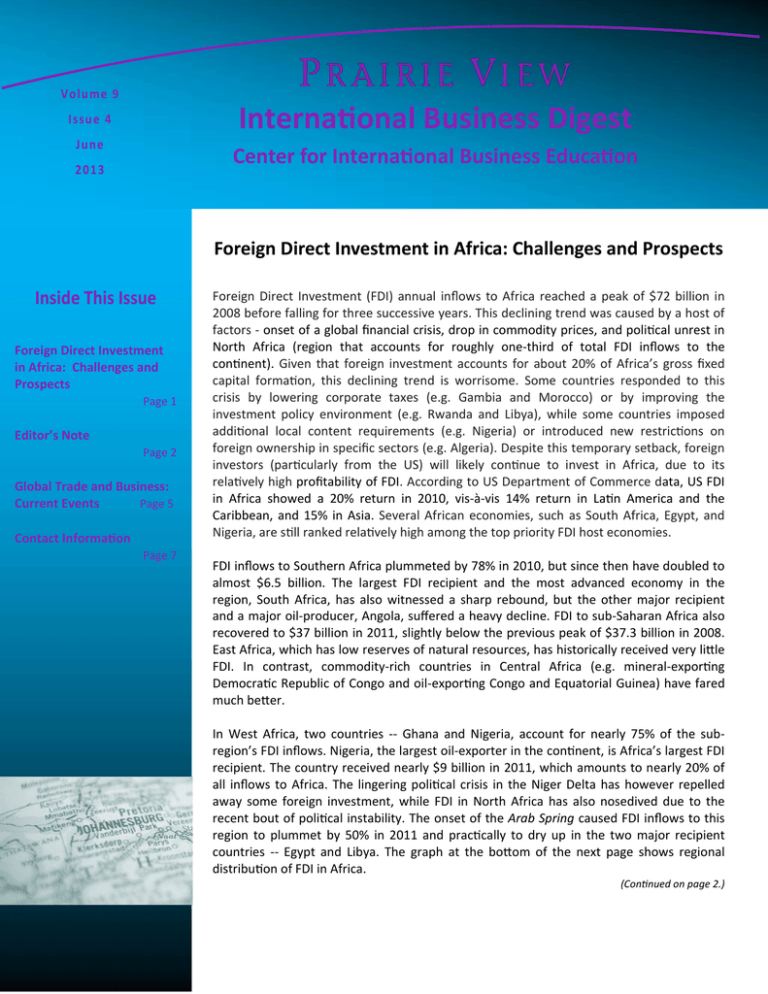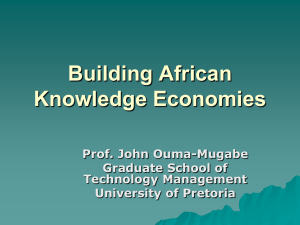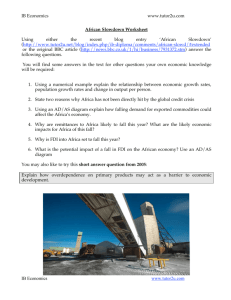Interna onal Business Digest Center for Interna onal Business Educa on
advertisement

Volume 9 Interna onal Business Digest Issue 4 June Center for Interna onal Business Educa on 2013 Foreign Direct Investment in Africa: Challenges and Prospects Inside This Issue Foreign Direct Investment in Africa: Challenges and Prospects Page 1 Editor’s Note Page 2 Global Trade and Business: Current Events Page 5 Contact Informa on Page 7 Foreign Direct Investment (FDI) annual inflows to Africa reached a peak of $72 billion in 2008 before falling for three successive years. This declining trend was caused by a host of factors ‐ onset of a global financial crisis, drop in commodity prices, and poli cal unrest in North Africa (region that accounts for roughly one‐third of total FDI inflows to the con nent). Given that foreign investment accounts for about 20% of Africa’s gross fixed capital forma on, this declining trend is worrisome. Some countries responded to this crisis by lowering corporate taxes (e.g. Gambia and Morocco) or by improving the investment policy environment (e.g. Rwanda and Libya), while some countries imposed addi onal local content requirements (e.g. Nigeria) or introduced new restric ons on foreign ownership in specific sectors (e.g. Algeria). Despite this temporary setback, foreign investors (par cularly from the US) will likely con nue to invest in Africa, due to its rela vely high profitability of FDI. According to US Department of Commerce data, US FDI in Africa showed a 20% return in 2010, vis‐à‐vis 14% return in La n America and the Caribbean, and 15% in Asia. Several African economies, such as South Africa, Egypt, and Nigeria, are s ll ranked rela vely high among the top priority FDI host economies. FDI inflows to Southern Africa plummeted by 78% in 2010, but since then have doubled to almost $6.5 billion. The largest FDI recipient and the most advanced economy in the region, South Africa, has also witnessed a sharp rebound, but the other major recipient and a major oil‐producer, Angola, suffered a heavy decline. FDI to sub‐Saharan Africa also recovered to $37 billion in 2011, slightly below the previous peak of $37.3 billion in 2008. East Africa, which has low reserves of natural resources, has historically received very li le FDI. In contrast, commodity‐rich countries in Central Africa (e.g. mineral‐expor ng Democra c Republic of Congo and oil‐expor ng Congo and Equatorial Guinea) have fared much be er. In West Africa, two countries ‐‐ Ghana and Nigeria, account for nearly 75% of the sub‐ region’s FDI inflows. Nigeria, the largest oil‐exporter in the con nent, is Africa’s largest FDI recipient. The country received nearly $9 billion in 2011, which amounts to nearly 20% of all inflows to Africa. The lingering poli cal crisis in the Niger Delta has however repelled away some foreign investment, while FDI in North Africa has also nosedived due to the recent bout of poli cal instability. The onset of the Arab Spring caused FDI inflows to this region to plummet by 50% in 2011 and prac cally to dry up in the two major recipient countries ‐‐ Egypt and Libya. The graph at the bo om of the next page shows regional distribu on of FDI in Africa. (ConƟnued on page 2.) Editor’s Note Gree ngs. It gives us great pleasure to bring to you the 36th issue of the Prairie View InternaƟonal Business Digest, an electronic quarterly newsle er produced by the Center for Interna onal Business Educa on. This issue features two sec ons. The first and main sec on (Foreign Direct Investment in Africa: Challenges and Prospects) discusses several important aspects of FDI in Africa, including current trend, regional and sectoral distribu ons, pa erns of foreign investment from emerging countries, par cularly China, economic impact of emerging country FDI in Africa, etc. The final sec on highlights selected global business/trade news and current events. Please note that all URL links are ac ve and you can go directly to a sec on from Dr. Rahim Quazi the Table of Contents sec on on the first page. Editor We hope you con nue to find this e‐newsle er a valuable channel for important informa on rela ng to interna onal business. We do hope our efforts will inspire greater number of local firms to seek out new global business opportuni es. Should you have any ques ons or sugges ons, please feel free to contact us. Thank you for your support. Rahim Quazi, Ph.D. Editor, Prairie View InternaƟonal Business Digest Prairie View A&M University ‐ College of Business E‐mail: rmquazi@pvamu.edu Phone: (936) 261‐9225 Fax: (936) 261‐9226 Foreign Direct Investment in Africa: Challenges and Prospects (ConƟnued from page 2.) (ConƟnued on page 3.) Prairie View Interna onal Business Digest Page 2 Volume 9 Issue 4 Foreign Direct Investment in Africa: Challenges and Prospects (ConƟnued from page 2.) Recent data on greenfield FDI projects in Africa however suggest that the primary sector is facing rising challenges from the manufacturing and service sectors. Although significant FDI is concentrated in the mining industry, the manufacturing sector accounted for over 40% of greenfield FDI during 2003‐2009. Industries that are currently drawing substan al FDI include construc on, electricity, gas and water distribu on, transporta on and storage, communica ons, petroleum products and nuclear fuel. Rising demand from an emerging middle class has also drawn huge FDI into banking, retail and telecommunica ons. The figure below shows distribu on of greenfield FDI by sectors during 2003‐2011. Intraregional FDI in Africa (from African home countries to African host countries) shows a rising trend. For example, FDI from South Africa to other African countries has increased more than four‐fold to almost $11 billion (from less than 5% in 2000 to 22% in 2008). Nearly 2,250 South African projects in other African countries were recorded in 2009; most of these projects were concentrated in infrastructure, telecom, mining and energy. Nearly 55% and 85% of outward FDI from Morocco and Tunisia is des ned for North Africa, and more than one‐third of FDI from Mauri us flows to Madagascar. Other na ons that receive significant intra‐African FDI include Tanzania (43% in 2005), Botswana (32% in 2007), Malawi (27% in 2004) and Madagascar (21% in 2005). In recent years, FDI from several emerging economies, such as China and India, to Africa has become significant. This upward trend has been fueled by the growing interna onaliza on of emerging country TNCs (Transna onal Corpora ons) and higher demand for natural resources in these fast‐growing economies. China has now become a major investor in sub‐Saharan Africa, primarily to safeguard its access to supplies of raw materials, which are essen al for its current drive toward massive industrializa on. Among other emerging economies, India, Malaysia and Russia have also invested substan al capital in Africa. These projects are o en undertaken by state‐owned enterprises, such as CNOOC (China), Petronas (Malaysia) and ONGC (India). The Chinese and Indian investors have invested heavily in infrastructure and manufacturing, par cularly in tex les and clothing industries. Since labor costs in Africa are comparable with these emerging countries, these investments do not yield significant savings on labor costs. However, the African Growth and Opportunity Act (AGOA) and the European Union’s Everything But Arms (EBA) ini a ves have granted African products special duty‐free and quota‐free access to developed country markets, which has prompted some of these emergency country investors to relocate their opera ons to Africa. (ConƟnued on page 3.) Prairie View Interna onal Business Digest Page 3 Volume 9 Issue 4 Foreign Direct Investment in Africa: Challenges and Prospects (ConƟnued from page 3.) Chinese FDI stock in Africa reached almost $8 billion by the end of 2008, which while impressive s ll accounted for only 4% of China’s total outward FDI stock (see the graph below). In addi on to the state‐owned enterprises, private Chinese investors have also been inves ng heavily in the con nent. FDI from India to Africa accounts for about 9% of total outward Indian FDI. Substan al amounts of Indian FDI have tradi onally been routed to third countries via Mauri us, which is due to its offshore financial facili es and favorable tax condi ons. In recent years, Indian investors have been inves ng in other countries including Côte d’Ivoire, Senegal and Sudan. During 1987‐2005, Malaysian TNCs such as Petronas and Telkom Malaysia were involved with nearly one‐fourth of all M&A purchases in Africa. Emerging country investors, many of whom are state‐owned enterprises, are generally less concerned than developed country investors about the impact of the global economic downturn on Africa. Their confidence/resiliency has helped the African countries ride out the last global financial crisis rela vely well. Another benefit of emerging country FDI is that much of it is invested heavily in labor‐intensive manufacturing sector, which has a high poten al for job crea on. During 2003–2005, the number of jobs created by emerging country FDI in Africa nearly doubled. Chinese investors are playing a vital role in building Special Economic Zones (SEZs) in several African countries. These SEZs should improve the infrastructure network, promote industrializa on, boost employment opportuni es and facilitate technology transfer. Technologies used by the emerging country TNCs are likely to be more compa ble with the current technologies in Africa, which should lead to rela vely effortless diffusion of knowledge to local producers and ul mately contribute to the structural advancement of African economies. Sources: World Investment Report (Annual Issues 2012, 2011, 2010), UNCTAD Prairie View Interna onal Business Digest Page 4 Volume 9 Issue 4 Global Trade & Business: Current News and Events Finance Guide: A Quick Reference Guide for U.S. Exporters This reference guide is designed to help especially small and medium‐sized U.S. enterprises learn the basics of trade finance. English and Spanish copies can be downloaded from: h p://export.gov/tradefinanceguide/. Intellectual Property (IP) Protec on This website (www.stopfakes.gov) has many resources (online training, country‐by‐country tool kits and guidance on repor ng infringement) that will help U.S. businesses protect their innova ons and market products safely at home and abroad. OPIC Annual Report 2012 The Overseas Private Investment Corpora on Annual Report addresses the challenges of inves ng in the developing world. Full report available at: h p://www.opic.gov/sites/default/files/files/OPIC_2012_Final.pdf. WEBINAR Series: Mexico’s Infrastructure Learn about the various ways the Mexican government is focused on improving its infrastructure on several fronts. Mexico has now matured as the top global manufacturing hub with world‐class facili es. Cost: $40 per webinar. Registra on informa on available at: h ps://emenuapps.ita.doc.gov/ePublic/newWebinarRegistra on.jsp?SmartCode=3Q63 Mexico’s Infrastructure Opportuni es 2013‐2018, June 27 ‐ 1 pm Central The Demand for Informa on and Telecommunica on Technologies in Mexico, July 25 ‐1 pm Central Future Transporta on Investment Plans in Mexico, August 22 ‐ 1 pm Central Mexico: A Market for Water and Environmental Technologies – Climate Change & Legisla on, September 5 ‐ 1 pm Central Mexico’s 6 year Energy Plan: Opportuni es in Oil & Gas, Electric Power and Renewables, October 24 ‐ 1 pm Central New Airport Projects in Mexico, November 21 ‐ 1 pm Central 5th Annual Harris County Interna onal Trade & Transporta on Conference, October 29. For more informa on, contact Caroline Binick (Caroline.Binick@cjo.hctx.net). Caribbean Clean Energy Forum – Santo Domingo, Dominican Republic, July 17‐18. Organized by the American Chamber of Commerce in DR, this forum will focus on the development of clean/ renewable energy projects in DR and the rest of the Caribbean region. More info available at: h p://www.amcham.org.do/energia/Eng/index.asp. OPIC Expanding Horizons Conferences Learn about poli cal risk coverage in emerging markets. Cost: $50. Salt Lake City, UT, July 7 Twin Ci es, MN, October 8 San Jose, CA, November 13 (ConƟnued on page 6.) Prairie View Interna onal Business Digest Page 5 Volume 9 Issue 4 Global Trade & Business: Current News and Events (ConƟnued from page 5.) U.S. Department of Commerce Export Compliance Programs This two‐day program will provide hands‐on training on various export compliance topics, including export regula ons compliance, export control requirements, classifica on of export products, electronic export informa on repor ng, etc. Orlando, FL, September 9‐10 Boston, MA, October 23‐24 Dallas, TX, November 6‐7 Savannah, GA, December 4‐5 Opportuni es in Central America Business Development Conference and Trade Mission, Costa Rica, July 15‐ 19. Trade mission par cipants will be able to a end the conference and have B2B mee ngs in any two of the following countries: Costa Rica, El Salvador, Guatemala, Honduras, Nicaragua and/or Belize. The mission is open to U.S. companies from a wide range of industries, but is focused on best prospects including construc on equipment/ road building machinery, medical equipment and devices, and safety/security. SelectUSA Investment Summit, Washington, DC, October 31 ‐ November 1. This two‐day summit will connect businesses and investors from across the country to promote investment in the US. Par cipants will interact with senior US government officials, business leaders and industry experts. More info is available at: h p://selectusa.commerce.gov/selectusa‐investment‐summit. Sources: Export News, U.S. Export Assistance Center, Houston Export News, U.S. Export Assistance Center, Aus n Prairie View Interna onal Business Digest Page 6 Volume 9 Issue 4 PVAMU College of Business Vision and Mission Statements Vision Statement: Our vision is to empower students from diverse backgrounds to become produc ve and ethical business professionals who are among the best in the world. Mission Statement: We provide a diverse student body with an educa on that creates highly produc ve professionals who are ethical, entrepreneurial, and prepared to succeed in the global economy. The College achieves this through excellence in teaching, research and service, and engagement with the business community and other stakeholders. The student experience is dis nguished by personal a en on, teamwork, leadership training, and apprecia on of the social responsibility of business. Prairie View A&M University College of Business P.O. Box 519; MS 2300 Prairie View, TX 77446 Next Issue ‐ September 2013 If you would like to receive an electronic version of this newsle er, please contact Dr. Rahim Quazi in the College of Business at 936‐261‐9225 or rmquazi@pvamu.edu Visit our website! www.pvamu.edu/business or www.pvamu.edu/pages/4478.asp







